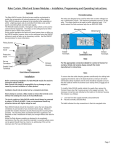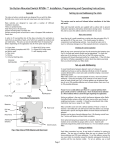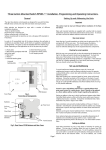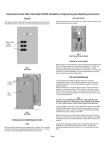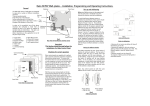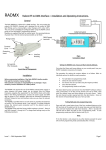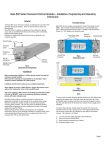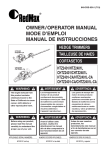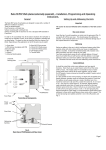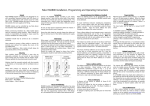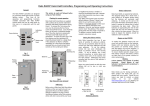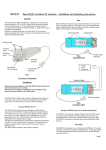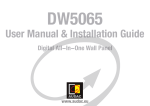Download Rako Curtain, Blind and Screen Modules
Transcript
Rako Curtain, Blind and Screen Modules – Installation, Programming and Operating Instructions. Before commencing installation of a Rako RACUB module first read this instruction manual carefully. Rako Controls Ltd accepts no responsibility for any damage or injury caused by incorrect installation of a Rako product. Scene 1 2 3 4 Off Relay A Closed Open Open Closed Open Relay B Closed Closed Open Open Open Fig 1. Default Settings When wired correctly the default settings will give Scene 2 = Open, Scene 3 = Stop and Scene 4 = Close, this allows operation from the Rako 3 and 6 button panels specifically designed for blind and curtain use (RPS03 and RPS06). During normal operation the Raise and Lower buttons have no effect on the RACUB module; however, they can be configured using the RASOFT software to work as faders or as momentary controls, particularly useful for Venetian blinds which may need fine adjustment. See the RASOFT documentation for more information. Note For blind and curtain motor control both relays should be used. This allows ‘neutral state’ where no power is applied to either coils of the motor, an in-built ‘delay on changeover’ feature also avoids hard reversing of a motor which can damage the relays. Installation should only be carried out by a competent electrician. Never attempt to connect a Rako module or remove the terminal covers without first isolating the circuit at the fuse/MCB board. The circuit supplying a Rako RACUB module should always be protected by either a 5A fuse or 6A MCB. Under no circumstances should any protection devices with higher ratings be used. Clamping bar B The Rako RACUB curtain, blind and screen modules allow control of most blind and curtain motors from Rako transmitters. Rako RACUB modules are designed to be installed either separately or within a lighting project and are controlled from Rako scene-sender panels transmitting Rako encoded radio signals. The RACUB module provides 2 isolated changeover relays which can be wired in a number of ways to suit the motor type being used. The relays can be configured to be either closed or open in each of the 4 scenes but the default settings are given below. Mounting Holes M Installation Once the supply and relay cables are connected ensure that the terminal covers are replaced and securely fastened, clamping the cable correctly as detailed above, before powering the unit. A General Supply Terminals Fig 2. Termination Area Output Terminals Note For the appropriate connection details for control of motors for curtains, blinds and screens always consult the motor manufacturer’s instructions. Rako modules are not designed for loop in/loop out connections. Should it be necessary to loop the supply on to further fittings then a junction box should be connected in circuit to facilitate this. With the supply and load connected and prior to switching on the supply ensure that the terminal covers are fitted and that they are securely clamping the cables. Set-up and Addressing Note: Rako RACUB modules should be mounted in areas that are adequately ventilated, dry and outside of any enclosed metal casings. Wherever possible the modules should be securely fixed using the mounting holes provided. The mounting holes are blanked off when supplied but are designed so that a woodscrew will easily cut through without the need for drilling. Whilst Rako modules are designed to be completely maintenance free the units should be mounted in a position where access can be gained should there be a fault or re-addressing of the unit be necessary (see ‘Set-up and Addressing’). Permissible loadings. The relays are designed to be used for either low or mains voltages but not a combination of both. The maximum permissible current is 2A per relay. If in doubt contact the Rako customer help-line on 01634 226666. To ensure that the cable clamping operates satisfactorily the cabling both supplying the module and to the load should be a minimum of 0.5mm with double safety insulation and the wires should be stripped to ensure that the cable bar within the terminal cover clamps firmly on both sets of insulation. 2 To install a Rako RACUB module isolate the supply then remove the Terminal Covers, giving access to the supply terminals. The necessary connections are indicated on the label on the dimmer housing. The notation is as follows: L – Live wire from the supply (normally coloured Brown) N – Neutral (normally coloured Blue) The label indicates the relay connections in their de-energised state. To avoid interference between rooms or neighbouring installations a Rako system should be set to an address other than the factory default of House 1 Room 4. The preferred addressing method is to select a logical House address number for the project and separate Room addresses for each room within the house. It may also be desirable to give each RACUB an individual channel address within the room (see Fig.4) if separate control of each blind or curtain motor is required (usually from programmable remotes via infra-red or centralised control systems via RS232). Note If the RACUB module is being installed in a physical room with other Rako lighting modules it may well be advisable to Address the Lighting and RACUB modules as separate ‘RAKO room numbers’ to allow separate control of the blinds and lighting. If this is the case then it is recommended to use sequential room numbers as this allows easier programming of a programmable Infra Red remote at a later stage. Addressing From An RPS03 Panel Setting the address switches. Step 1 C hannel 1 C hannel 2 Blin ds House 14 4 Room 7 Set address switches on controller Lighting House 14 4 Room 6 Step 2 Chan nel 2 Chan nel 1 House 14 4 Room 5 Note: Any control panels set with the same address will act as two or multi way controls. 144 Magnet Each Rako transmitter has two, 8 way banks of switches for setting its address. The two sets of switches allow the user to choose from 256 house addresses and 256 room addresses. To set the address, unclip the rear cover whereupon the banks of switches will be now become visible. To set an address, use a small terminal screwdriver or similar device and carefully move some of the switches into the ‘ON’ position. Addressing uses binary encoding and the value of the switches is shown in Fig. 4. Hold magnet against casing until LED illuminates Fig 4. Addressing Example Step 3 House address = 128+16=144 ROOM 128 64 32 16 8 4 2 1 ON BINARY VALUE HOUSE 128 64 32 16 8 4 2 1 ON BINARY VALUE To Set an Address. Room address = 32+4=36. Fig 3. Addressing Switches Notes on addressing. A RACUB will not receive an address of House 0 (All switches set to off) A RACUB will respond to, but not receive an address of Room 0 (All switches set to off). This Room 0 address is used for ‘Master House’ control A RACUB cannot be set to channel 0. To program a lighting scene see Wall panel or Hand held manual. RACUB modules can be addressed either by a standard Rako RCP07 panel or an RPS03/06 panel. Using an RCP07 individual channel addresses can be assigned to each module. To set an address from an RCP07 panel follow the steps shown in ‘Initial Addressing of a Rako Receiver Module’. To set an address from and RPS03/06 control panel follow the steps given in ‘Addressing from an RPS03’. Remove magnet when LED starts to flash Module is now in set-up mode LED flashes to confirm address command is sent Step 4 Press and hold both buttons for 5 seconds Programming RACUB units from an RCP07 The relays in a RACUB unit can be programmed using an RCP07 wallplate or from RASOFT software. To program the relay settings follow the wallplate instructions for programming a scene. Program the RACUB as though the level was being set in a dimming module, the way that the relays respond is given below. Level Relay A Relay B 76-100% Closed Closed 51-75% Open Closed 26-50% Closed Open 0-25% Open Open Special Features. The Rako RACUB module has some in-built features and some special features that can be set using RASOFT software, these include. Timeout After 5 minutes the relays in the RACUB module will both open. This feature allows blinds or curtains time to travel to their full extent but not be left with permanent power on. If a blind/curtain motor is miswired or wired using only one relay then this feature can cause the motor to reverse after the time-out period. The timeout can be disabled using RASOFT but correct wiring is the preferred option. Momentary Action This feature enables the RACUB unit to respond to the raise/lower commands from an RCP07 wall panel and with the motor only operating all the time that a button is depressed. If the latch after box is checked then after the set period of time the button can be released and the motor will still operate. This feature is primarily used for operation of Venetian blinds where the tilt angle needs to be set by small adjustments but latching after a short time is desirable to fully open or close the blinds. Step 3 TABLE 1 Action Step up one channel and ident Step down one channel and ident Ident No action Exit programming Hold the magnet against casing at point indicated on the label until LED illuminates and keep the magnet held with the LED on until it starts to flash. Then remove magnet. Module is now in set-up mode. Note: If a receiver is already addressed to a controller (for example a receiver is addressed to the controller but with the wrong channel number) then the LED will be flashing as soon as the panel is put into programming mode. It will, however, still be possible to re-address this receiver using the magnet as normal. Step 4 Go to the receiver to be addressed Step 2 TIP Press the scene button first Note Step 5 Press Off button to exit controller from programming mode Step 6 Is there another receiver in the room to be addressed YE S NO To add a new receiver to an existing installation step up through the channels to an available channel number. It is possible to tell which channels modules are addressed to by looking at the LED in the module. When the channel address for a module is reached, instead of pulsing the LED will momentarily go solid. YE S Note: When in programming mode the buttons have functions as detailed in table 1. Note: A Rako panel will always enter programming mode at Channel 0. It is not possible to give a receiver an address of Channel 0 but this gives a consistent starting point. Put controller into programming mode by pressing and holding a scene button and both raise and lower buttons together. After 5 seconds the red LED on the panel starts to flash. The panel is now in programming mode. Release the buttons Press button 3 to send the ident of the channel selected in step 3. Receiver automatically returns to normal mode (blue LED goes out) while controller remains in programming mode (red LED keeps flashing) Press button 1 once to step up one channel. If this is the desired channel i.e. Channel 1(for the 1st receiver) then go to Step 4. If not, press button 1 again to step up to channel 2 (for the 2nd receiver), again to step to channel 3 etc, until the d esired channel number is reached (maximum = 15). It is this channel number (along with the House and Room address) that is sent to the receiver in Step 5. If at any point it is necessary to step down a channel, press button 2 once. Button 1 2 3 4 Off Pick an House address from 1-255 (keep same address for all panels in house) Select Room addresses from 1-255 for each room (Room 0 is master house control) Set address switches on controller Step 1 Is the controller still in programming mode (red LED flashing) NO Note: In the following procedure both the controllers (wallpanels and hand held remotes) and the receivers have an automatic time out after approximately 3 minutes when in programming or set-up mode. This feature avoids the possibility of either being left permanently in programming or set-up mode. This may cause confusion if either the controller or receiver times out before the procedure is complete. It is worth becoming familiar with the procedures before starting the addressing procedure. If at any time it is necessary to start again the controllers can be returned to normal mode by pressing the ‘Off’ button and the receivers by resetting the electrical supply. Initial Addressing of a Rako Receiver Module L,N N 240 v Protected 6A Suppy L L,N L N N NL SUPPLY INPUT VOLTAGE 220-240V 50Hz Black N (1) L C URTAIN S CR EE N A ND BLI ND CO N TRO L U N IT 4 Way Junction Box (2) N L Junction Box L N L,N NL SUPPLY INPUT VOLTAGE 220-240V 50Hz C URTAIN S CR EE N A ND BLI ND C ON TRO L U N IT Brown M Blue Somfy MAXIM UM LO AD 2 A PER REL AY A 240v to 12v or 24v DC Supply B Note M Do not co nnect tw o motors in para llel (use tw o RACUB units) MAXIM UM LO AD 2 A PER REL AY A 240 v Protected 6A Suppy L B Links (De pendant o n the motor) Blue Brown Black Link L Somfy 240V Blind Motor (1) (2) L, (1), (2) Somfy 24vDC Blind Motor (Blue, Brown, Blac k Cab le Conne ctions) Drawing Title Drawing Title Connection Diagram For RACUB to 240v Somfy Blind / Screen Motor Connection Diagram For RACUB to L.V. DC Somfy Motor Drawing N o Drawing N o Notes RD 1005 Rev A Drawn Ch ecked DA AG Scale Date Notes NTS 18/3/05 Tel 0870 043 3905 Fax 0870 043 3906 RD 1007 Rev A Drawn Ch ecked www.rakocontrols.com DA AG Scale Date NTS 18/3/05 Tel 0870 043 3905 Fax 0870 043 3906 www.rakocontrols.com




